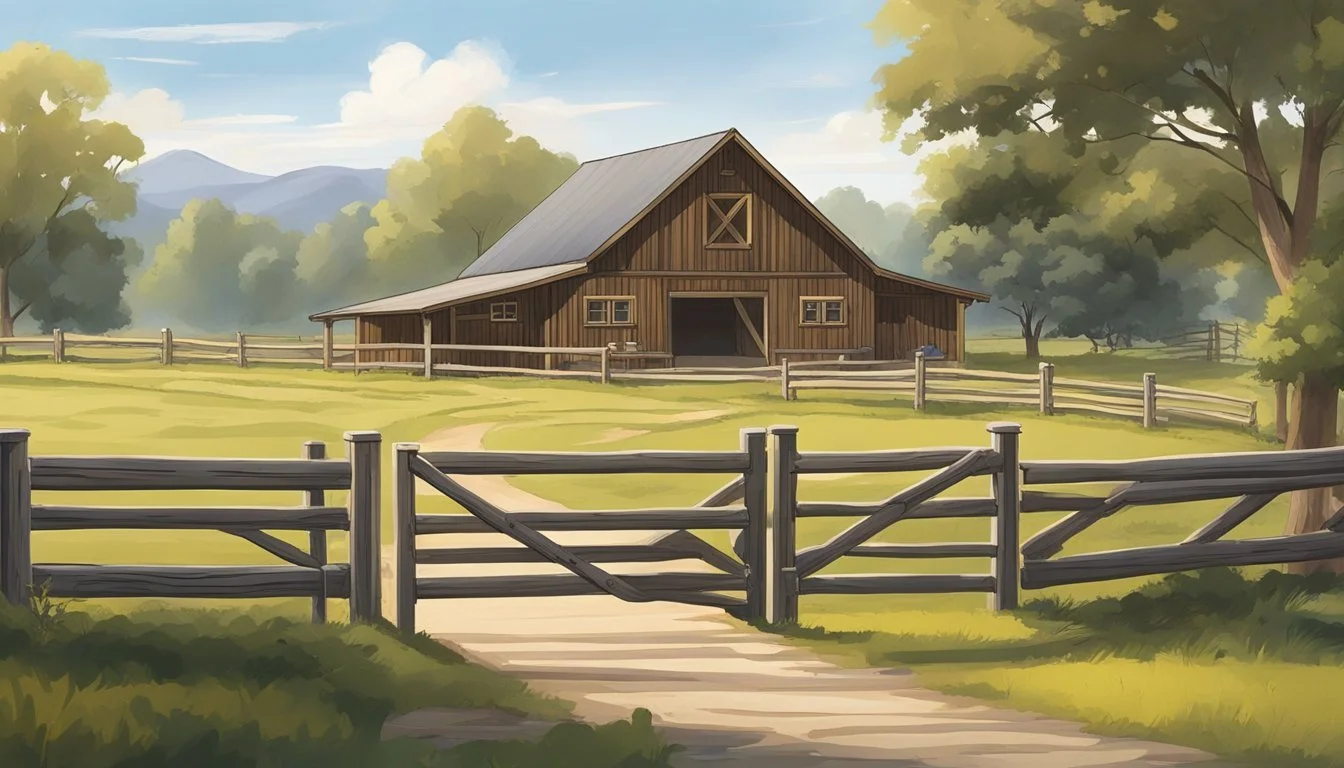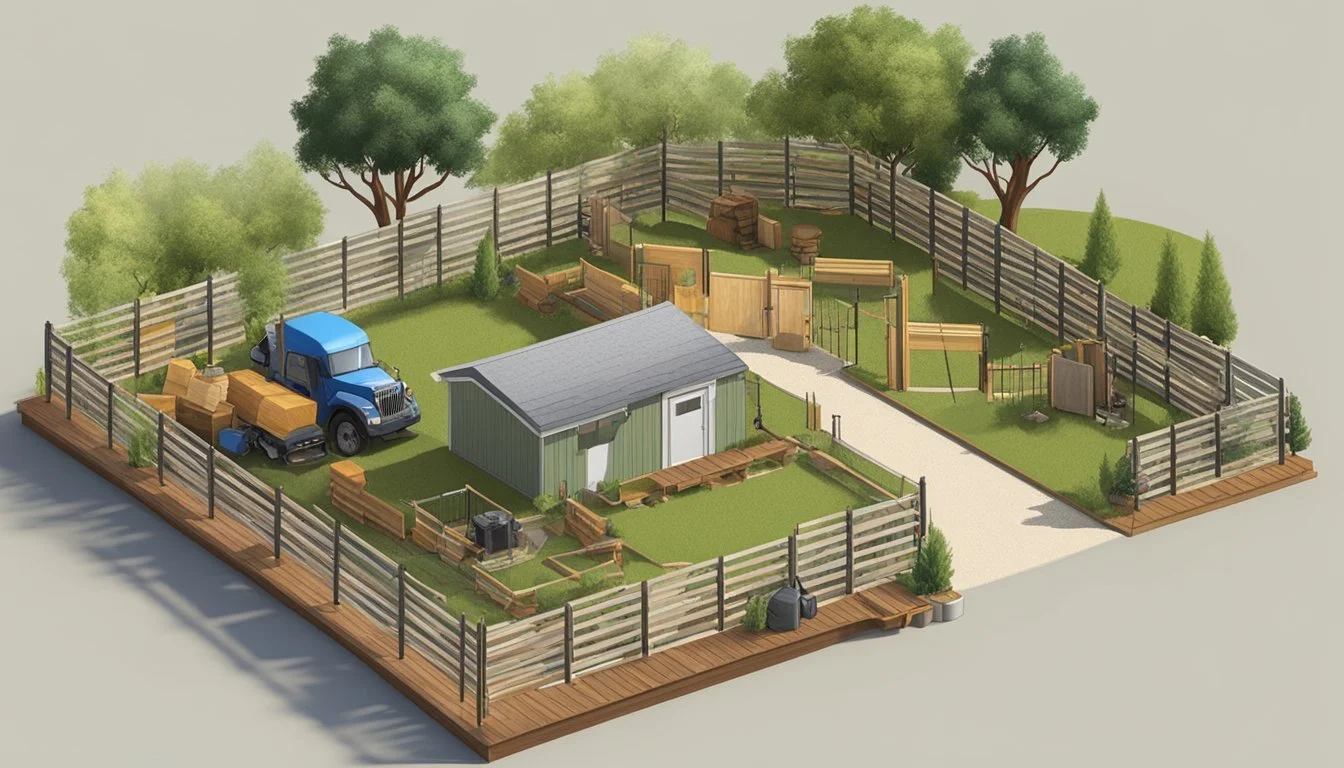The Best Fencing Materials for Your Ranch
Durability Meets Design
Selecting the best fencing material for your ranch is a critical decision that impacts not only the security of your animals and property but also the long-term maintenance and aesthetic of your ranch. The classic wood fence, with its timeless design, has been a staple due to its versatility in construction and natural appearance. However, more modern materials like vinyl offer durability with minimal maintenance, a key consideration for property owners who value longevity and ease.
When considering the types of fence for your ranch, it's essential to assess factors such as the types of animals you have, the climate conditions of your area, and the level of security required. For instance, electric fences are highly effective for containing livestock and deterring predators, while barbed wire and woven wire fences are often used for their strength and durability. For horse farms, a fence with horizontal rails – or a combined design using mesh for added security without sharp edges – provides both containment and safety for these valuable and sometimes skittish animals.
Ranch fencing must balance practicality with design preferences. For areas requiring rigid barriers, high-tensile steel mesh or welded wire fences are suitable options. Synthetic materials offer a modern twist on traditional designs, often replicating the rustic charm of wood while providing resistance to weather and animal damage. Whether opting for the sturdy, classic wooden post and rail or exploring innovative synthetic options, the ideal ranch fencing solution should offer a harmonious blend of functionality and aesthetic appeal tailored to the owner's unique needs and preferences.
Evaluating Fencing Needs
Choosing the right fencing for a ranch involves a thoughtful examination of the property's specific needs and challenges. This section discusses how to determine the most appropriate fencing by considering the size of the ranch, the types of livestock it houses, and the environmental factors that could impact fencing choices.
Determining Ranch Size and Livestock Requirements
Ranch Size: The total acreage of the ranch influences both the length of the fencing and the type required. Large properties often benefit from cost-effective and low maintenance solutions like barbed wire or electric fences. In contrast, smaller areas might prioritize more aesthetically pleasing options like wooden fences or vinyl fencing.
Livestock Type and Behavior: The variety of animals on the ranch plays a crucial role in selecting a fence. For fences for horses, ranchers typically choose rail fences or vinyl fencing that provide a barrier without causing injury. Cattle may require a sturdier structure such as a woven wire or high-tensile steel mesh.
Containment vs. Protection: Livestock containment necessitates durable fences like electric wires or woven wire fences. Protecting livestock from predators may warrant a combination of electric fencing and fixed-knot fences with smaller mesh spacing.
Assessing Environmental Factors
Climate: Weather conditions can drastically affect the durability and maintenance needs of ranch fencing. Humid climates may compromise the integrity of wood materials, while synthetic fencing or vinyl might better resist weathering.
Geography: Properties on uneven terrain might require flexible fencing options like welded wire fences that can mold to the landscape. Open, flat areas could utilize simpler designs, like barbed wire with strategically placed wooden posts for extensive perimeters.
Vegetation and Wildlife: Proximity to wooded areas or high vegetation might attract wildlife, which necessitates a more robust fence, possibly with electric wires or tighter woven wire mesh to prevent animal damage.
Ranch owners should take into account not just immediate needs but also long-term goals for property development when considering their fencing options. Whether seeking to highlight the rustic charm of a traditional ranch or to provide minimal maintenance solutions, understanding these core factors is essential for an appropriate and lasting fence installation.
Fencing Materials Overview
Selecting the right fencing material is crucial for the balance of durability, maintenance, and aesthetic appeal. This section examines the advantages and limitations of commonly used materials.
Wooden Fences: Pros and Cons
Pros:
Affordable: Wood is a cost-effective option for fencing, making it a go-to for ranch owners.
Ease of Installation: Wooden fences can be easier for property owners to install than some other types.
Cons:
Maintenance: Wood is susceptible to rot and requires regular treatment to maintain its integrity.
Durability: Even when treated, wood may not hold up as well as metal or synthetic materials.
Metal Fences: Types and Uses
Types:
Steel: Known for its strength and durability.
Galvanized Tubing: Often used for more open fence designs and may incorporate wire mesh.
Uses:
Large livestock containment: Metal fences offer a sturdy barrier that can handle the physical demands of larger animals.
Security: Provides a high level of protection against predators and trespassers.
Synthetic Options: Vinyl and PVC
Pros:
Durability: Vinyl and PVC fences are highly resistant to weather conditions and require minimal maintenance.
Ease of Maintenance: These materials do not rot and do not need to be treated for weather resistance.
Cons:
Cost: Synthetic materials often come at a higher upfront cost when compared to wood.
Incorporating these materials into a ranch's fencing solution must be considered carefully, taking into account the specific needs of the ranch and the animals involved.
Fence Construction and Installation
When building a ranch-style fence, understanding the requirements for constructing and installing posts, rails, wires, panels, and gates is essential. This section will guide you through these crucial elements to ensure stability, durability, and functionality.
Setting Posts and Rails
For a sturdy fence, setting the wooden posts correctly is foundational. Begin with holes approximately two feet deep for wooden fence posts, ensuring they align with the predetermined fence layout. Use concrete to secure the posts, allowing for ample drying time. Next, attach horizontal rails between posts for a wood fence, or use T-posts and stays for wire fences. The standard fence height should be determined by the type of livestock contained; horse farms often employ taller fences than those used for more docile animals.
Attaching Wires and Panels
For woven wire fencing constructions, begin by unrolling wire next to the line of posts, attaching it securely at each post. Cattle panels or welded wire fences require that panels be fastened to the posts with fencing clips or wire. Electric fences should have horizontal wires attached to insulators, maintaining correct mesh spacing to prevent animal escape or injury. Barbed wire fences are constructed similarly, with horizontal wires held taut between posts. Regular maintenance is necessary to keep wire tension and prevent sagging.
Installing Gates and Entrances
The final step in the fence installation process is setting up gates and entrances, critical for efficient ranch operations. Determine gate width based on the largest equipment used on the property. Gates for livestock movement should be wide enough to prevent injury and stress to the animals. Utilize heavy-duty hardware and ensure the gate swings freely and latches securely. For electric fencing, install gate handles with insulators and spring-loaded systems to maintain the charge.
Constructing and installing a ranch fence requires careful planning, appropriate materials, and meticulous labor. Whether you use classic wood materials or more modern synthetic options, your fence can offer the perfect balance of form, function, and minimal maintenance.
Maintenance and Upkeep
Regular maintenance and upkeep are crucial for the longevity of any ranch fencing. This involves consistent inspections and immediate repair of any damage to ensure that your quality fences continue to serve their purpose effectively.
Regular Inspection and Repair
Inspection: Ranch owners should schedule regular examinations of their fencing systems. Look for signs of wear or damage, such as:
Broken or bent wires
Loose or missing wooden posts
Damage from weather or animals
Malfunctioning electric fence chargers
Repair:
Barbed wire fences may require re-tightening of loose wires and replacement of sections with broken barbs.
For wood fences, replace cracked boards and attend to rot, particularly in wooden fence posts.
Welded wire or woven wire fences should be checked for broken welds or bent wires; repairs may involve patching or completely re-weaving sections.
Electric fences need checks on insulators, electric wires, and fence chargers to ensure they are functioning correctly.
Dealing with Weather and Wildlife Impact
Weather:
Wind, snow, and rain can cause various damages, from knocking down sections of rail fences to rusting metal components.
Wood fencing can suffer in humid climates due to moisture causing warping or rot.
Vinyl fences and electric fences typically require minimal maintenance but should be checked for damage after severe weather.
Wildlife:
Encounters with farm animals and wildlife can lead to damage. Fence meshes need to be of appropriate sizes to prevent animals from getting stuck.
Electric fencing can be an effective deterrent against wildlife and should be kept in optimal working condition.
Horse rail fences designed for horse farms often uses a combination of wood materials and synthetic materials for durability and to minimize injury to animals upon impact.
In summary, proactive and ongoing maintenance tailored to the specific type of fence is key to ensuring both the security and longevity of your ranch's perimeter.
Financial Considerations
When planning to erect fencing on a ranch, financial considerations play a crucial role. The type of fence chosen directly affects both the initial outlay and the ongoing maintenance costs.
Types of Fencing and Costs:
Barbed Wire Fences: Cost-effective and durable, suitable for large pastures.
Electric Fences: Lower initial costs but require ongoing electricity and potential repairs to fence chargers.
Wooden Fences: Higher initial investment, especially for treated wooden posts and rails, but offer a classic design.
Woven Wire Fences: Include a variety of mesh sizes; can be more expensive due to the amount of metal and labor involved in installation.
Vinyl Fences: Lower maintenance but higher upfront cost compared to wood fencing.
Maintenance and Durability:
Minimal Maintenance: Synthetic fences, such as vinyl, require less upkeep.
Regular Maintenance: Wood fences may need more care to prevent rot or animal damage.
Longevity and Conditions:
A high-tensile steel mesh offers longevity, especially for woven or welded wire fences.
In a humid climate, consider the potential for rust and necessary treatments for metal fences or decay for wood materials.
Selecting the Fence: Budget and property needs lead the selection process:
Permanent vs. Temporary Fences: Fixed-knot and field fences for long-term, versus electric wires for temporary needs.
Animal Containment: Cattle panels and woven wire for docile animals; barbed wire and electric fencing for larger, more robust livestock.
Fence Project Costs:
Project size
Material prices
Labor for installation
Future maintenance costs
In summary, ranch owners must balance the initial costs of materials and installation with the expected lifespan and long-term care expenses. Efficiency and utility should align with the budget without compromising on the necessary containment and property boundary needs.






